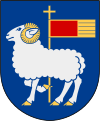Hemse Church
| Hemse Church | |
|---|---|
| Hemse kyrka | |
|
Hemse Church, external view | |
 Hemse Church | |
| 57°13′58″N 18°22′22″E / 57.23278°N 18.37278°E | |
| Country | Sweden |
| Denomination | Church of Sweden |
| Administration | |
| Diocese | Visby |
Hemse Church (Swedish: Hemse kyrka) is a medieval Lutheran church in Hemse on the island of Gotland, in the Diocese of Visby (Sweden).
History
.jpg)
The current stone church in Hemse dates mainly from the 13th century.[1] However, about a century earlier there was a stave church built at the same location.[1] The surprisingly well-preserved stave church was found by chance under the floor of the stone church during a restoration in 1896, where the wooden planks of the church had served as an earlier floor.[1][2][3] The wooden church, known as Hemse stave church, is the most well-preserved early stave church found in Sweden.[1][2][3] There have been plans to erect a replica of the church somewhere near its original location.[4]
The stave church was probably replaced by the presently visible Romanesque stone church as it became too small for the congregation. The nave and choir were built first, and somewhat later the tower was added.[1]
During the aforementioned restoration the church was rather insensitively restored inside.[3] A later restoration was carried out in 1962–63.[1]
Architecture
The church is a relatively homogeneous Romanesque edifice. Inside, it is decorated by medieval frescos. The oldest of these are in the tower, and depict centaurs assaulting the tree of life. Under it are two inscriptions in Latin. In the choir and the apse are depictions of the Last Judgment dating from the 14th century and in the nave, frescos from the middle of the 15th century depicting the Passion of Christ and two saints: Saint George and the Dragon and Saint Martin. There is also a rune inscription on the western wall of the choir, a repetition of the futhark or runic "alphabet".[1]
Among the furnishings, the triumphal cross from the end of the 12th century is noteworthy. The baptismal font has a Romanesque foot but a later (14th century) basin. The church bell is from the first half of the 15th century.[1]
See also
References
- 1 2 3 4 5 6 7 8 Lagerlöf, Erland (1973). Lagerlöf, Erland, ed. Gotlands kyrkor (in Swedish). Uddevalla: Rabén & Sjögren. pp. 180–182. ISBN 9129410355.
- 1 2 Enderborg, Bernt. "Hemse kyrka, Gotland". guteinfo.com (in Swedish). Retrieved 17 August 2013.
- 1 2 3 "Hemse kyrka" (in Swedish). Svenska kyrkan (Church of Sweden). Retrieved 17 August 2013.
- ↑ "Hemse vill återuppbygga stavkyrka" (in Swedish). Sveriges radio (Radio Sweden). Retrieved 17 August 2013.
External links
 Media related to Hemse church at Wikimedia Commons
Media related to Hemse church at Wikimedia Commons- Official site (in Swedish)
Coordinates: 57°13′58″N 18°22′22″E / 57.23278°N 18.37278°E
